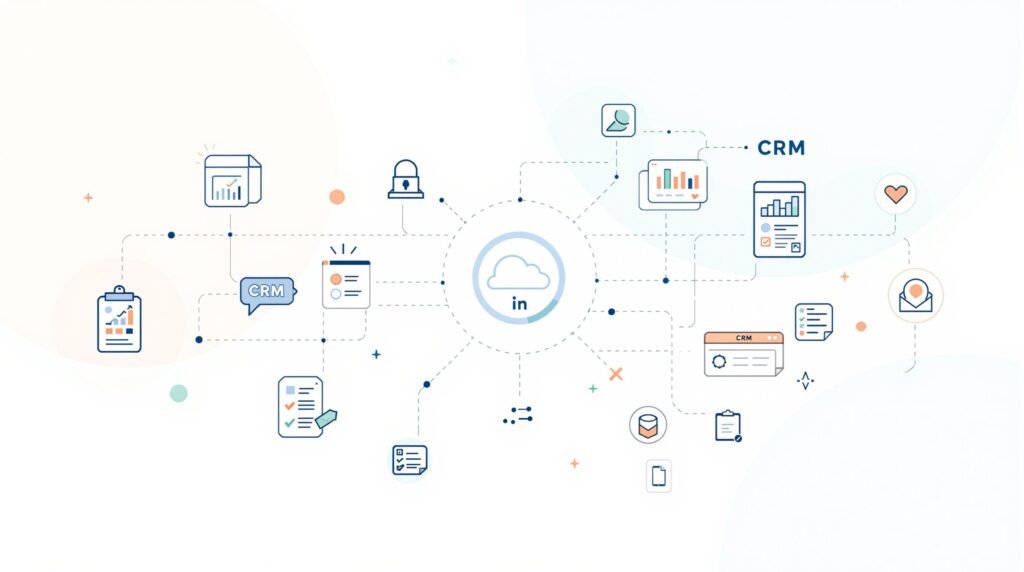Want to simplify your marketing workflow? Integrating your CRM with tools like email platforms, e-commerce systems, and social media can save time and boost efficiency. Here’s how:
- What is CRM Integration? It connects your CRM with other tools, automating data flow and reducing manual work. For example, syncing Shopify with your CRM updates customer data instantly after a purchase.
- Why Integrate? Companies like Thomson Reuters saw a 72% faster lead conversion and 175% higher revenue by aligning sales and marketing tools.
- Popular Tools to Integrate with GoHighLevel:
- Email Services: Mailgun, SendGrid
- E-commerce: Shopify
- Social Media: Facebook, Instagram
- Webinars: Zoom, WebinarJam
Steps to Get Started:
- Audit your tools and prioritize integrations.
- Clean your data to avoid errors (e.g., deduplicate records).
- Set up API keys and secure access.
- Start integrating tools like email platforms, Shopify, and Zoom.
Pro Tip: Automate workflows like lead follow-ups or purchase-related emails to improve customer engagement.
How to Integrate Shopify in GHL
Getting Ready for Integration
Now that you’re familiar with the advantages of integration, it’s time to prepare your systems for smooth connectivity.
Review Your Current Tools
Start by evaluating your existing tech stack. Document all your current marketing tools and their specific roles in your workflow.
Here’s a quick audit guide to help you assess your tools:
| Tool Category | Key Assessment Points | Integration Priority |
|---|---|---|
| Email Marketing | Deliverability rates, automation features | High – Direct customer communication |
| E-commerce | Transaction volume, customer data fields | High – Revenue tracking |
| Social Media | Engagement metrics, lead capture methods | Medium – Campaign attribution |
| Analytics | Reporting needs, data visualization | Medium – Performance tracking |
Clean and Organize Data
Did you know poor data impacts 98% of companies, costing an average of 12% in revenue [3]? As Jacque Turbett from New Breed explains, dirty data can lead to misleading insights [2]. To avoid this, take these steps to clean and organize your data:
- Data Standardization
Ensure consistent formatting for key data points such as:- Phone numbers (e.g., +1-555-0123)
- Company names (e.g., standardize “Inc.” vs. “Incorporated”)
- Job titles (e.g., unify hierarchical titles)
- Addresses (e.g., follow USPS guidelines)
- Deduplication Process
With 10-25% of B2B database contacts containing errors [4], it’s essential to identify and merge duplicates. Tools like GoHighLevel’s deduplication feature can help:- Combine duplicate customer records
- Keep the most recent contact details
- Retain valuable historical interaction data
- Data Validation
Use automated checks to ensure:- Proper email address formatting
- Accurate phone number formatting
- Completion of required fields
- Consistency across custom fields
Set Up Technical Access
Getting the right API access is critical for successful integration. API keys serve as unique identifiers and authentication tokens for your connected platforms [5].
“An application programming interface (API) key is a code used to identify and authenticate an application or user. API keys are available through platforms, such as a white-labeled internal marketplace. They also act as a unique identifier and provide a secret token for authentication purposes.” – Fortinet [5]
Here’s what to do:
- Generate individual API keys for each platform integration.
- Limit API access to specific IP addresses.
- Set usage limits to avoid overloading.
- Store API credentials securely.
- Regularly monitor API activity for unusual patterns.
Once your tools and data are ready, you can move forward with connecting your platforms to GoHighLevel.
How to Connect Tools to GoHighLevel

Once your tools and data are ready, here’s how you can integrate your platforms with GoHighLevel step by step.
Email Marketing Setup
Follow these steps to connect your email marketing platform:
- Open Integration Settings
Go to Settings > Integrations in your GoHighLevel dashboard. You’ll see a list of supported email platforms, such as Mailchimp [6]. - Generate and Copy Your API Key
For Mailchimp users:- Navigate to Account > Extras > API keys.
- Create a new API key with the necessary permissions.
- Copy the generated key [6].
- Complete the Integration
Paste your API key into GoHighLevel’s integration settings and set up your synchronization preferences:Setting Type Configuration Options Recommended Choice Contact Sync One-way or Two-way Two-way for full automation Sync Frequency Real-time or Scheduled Real-time for immediate updates List Mapping Single or Multiple Lists Multiple for segmented campaigns
Once your email platform is connected, move on to linking Shopify for e-commerce.
Shopify Connection Steps
Sync your Shopify store to automate customer data and marketing efforts:
- Open your GoHighLevel dashboard and find the Shopify integration option.
- Click “Connect” and authorize GoHighLevel in your Shopify admin.
- Map data fields between the platforms, including customer information, order details, product catalogs, and transaction history.
After Shopify, you can integrate Zoom to streamline your meeting processes.
Zoom Integration Guide

Use the Zoom integration to schedule meetings and automate follow-ups. This feature is included in all GoHighLevel subscription plans [8].
Here’s how to set it up:
- Go to Settings > Profile > Integrations.
- Find and select the Zoom integration option.
- Log in using your Zoom credentials.
- Authorize GoHighLevel to access your Zoom account [7].
For calendar configuration:
| Setup Step | Action Required | Purpose |
|---|---|---|
| Calendar Selection | Choose your Zoom calendar | Automate meeting creation |
| Link Generation | Enable dynamic links | Create unique meeting URLs |
| Testing | Book a test appointment | Verify meeting ID generation |
After completing these integrations, test each one thoroughly. Keep an eye on data flow between platforms and fine-tune your settings to improve performance as needed.
sbb-itb-1c6633a
Making the Most of Connected Tools
Lead Management Automation
You can simplify lead management by using trigger-based actions to guide and engage leads effectively [9].
Here’s how to get started:
- Set up forms to:
- Direct leads to the right team members
- Tag contacts based on their source or interests
- Activate welcome sequences
- Schedule timely follow-ups
- Create Multi-Channel Follow-ups
Build automated workflows that combine email, SMS, and voice messaging to keep your leads engaged across different platforms.
| Automation Type | Trigger Event | Action Sequence |
|---|---|---|
| New Lead | Form Submission | Welcome email → SMS reminder → Call task |
| Appointment | Booking Confirmed | Confirmation email → 24hr SMS reminder → Survey |
| Purchase | Order Complete | Thank you email → Cross-sell offer → Review request |
Customer Data Organization
After automating lead workflows, focus on organizing customer data so you can take more targeted actions [10].
Use custom fields, apply tags, and automate data cleanup processes. Standardizing naming conventions is another simple but effective way to ensure all your data stays clear and actionable.
This structured approach makes generating accurate reports much easier.
Simplified Reporting
GoHighLevel’s built-in reporting tools offer a clear view of your marketing performance across all connected platforms [11].
Key Reporting Features:
- Attribution Tracking:
- Measure conversions to assess campaign success
- Identify top-performing channels
- Monitor phone conversion rates
- Performance Analytics:
- Track campaign engagement
- Review email and SMS delivery rates
- Measure appointment attendance
- Analyze how quickly deals move through your sales pipeline
Make it a habit to review these reports weekly. Adjust your strategy based on the insights you uncover. With integrations for Google and Facebook Ads, you can track performance in one place. Use custom dashboards to highlight your most important metrics and focus on the KPIs that matter most to your business goals.
Fixing Common Integration Problems
Data Sync Fixes
Data synchronization glitches can throw a wrench in your workflow. Here’s how to tackle some common issues:
- Field Mapping Errors: When data ends up in the wrong fields, it’s often due to misaligned mappings. Use a standardized field mapping template to avoid this, paying close attention to custom fields that could cause problems.
- Business Name Consistency: Inconsistent business names can result in separate company records instead of linking contacts. Use Company Object Automation to standardize names, delete incorrect entries, and re-import corrected data.
Once these steps are complete, make sure to clean up your database by addressing duplicate records.
Removing Duplicate Records
Did you know that 20–30% of CRM databases contain duplicate records? This can cost companies around $12.9 million annually [12]. Here’s how to clean things up:
- Automated Cleanup: Set up deduplication rules using key identifiers like email addresses, phone numbers, company names, or custom fields.
- Manual Review: Plan quarterly reviews to focus on new contacts, high-value accounts, integration touchpoints, and older data.
API Connection Help
If you’re facing API issues with GoHighLevel, here’s what to do:
- Authentication Check: Confirm your API key is valid and ensure endpoint configurations are set up correctly.
- Connection Monitoring: Enable logging to track API activity. This will help you spot patterns in connection failures, whether they’re caused by rate limits, network settings, authentication issues, or data formatting problems.
If the issues persist, consider joining the GoHighLevel developer Slack community or attending their Developer Council Call, held on the second to last Friday of each month.
Implementing these fixes will help keep your integrations running smoothly.
Next Steps
Integration Benefits Review
Integrating your tools with GoHighLevel helps simplify your daily tasks. For example, a digital marketing agency improved its workflow by using GoHighLevel’s sub-account structure to manage multiple client accounts. With a unified dashboard, they could track key performance indicators in one place, cutting down on the need for separate tools and platforms [1]. Follow this guide to kick off your integration process smoothly.
Getting Started Checklist
Here’s a step-by-step checklist to help you get started:
- Technical Setup
- Back up customer data and confirm all credentials are accurate.
- Map out your workflows to ensure nothing gets missed.
- Configure key performance indicators in the dashboard for easy tracking.
- Integration Priorities
- Link your email marketing platform.
- Set up payment processing features.
- Enable appointment scheduling tools.
- Add lead capture forms to your website.
- Sync your social media advertising accounts.
- Quality Assurance
- Test integrations to ensure everything works as expected.
- Check that data syncs correctly between tools.
- Monitor automation triggers for any issues.
- Keep track of and address any problems during the setup.
One example of success: A local fitness studio integrated its website forms, SMS reminders, and email marketing platform to streamline lead capture and automate follow-ups. By using the unified dashboard to review performance metrics, they refined their marketing approach and boosted member sign-ups [1].


